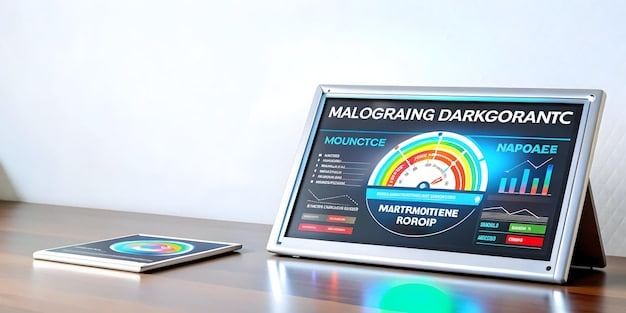Customer Acquisition Cost (CAC): A 2025 Guide for Startup Growth

Customer Acquisition Cost (CAC) is a vital metric for startups to understand how much it costs to acquire a new customer, enabling informed decisions for growth strategies and resource allocation, especially crucial for sustainable scaling in 2025.
Navigating the startup landscape requires a keen understanding of key metrics, and among the most important is the Customer Acquisition Cost (CAC). Knowing your CAC helps you understand the efficiency of your sales and marketing efforts. This guide will explore how to accurately calculate CAC and optimize it for successful startup growth in 2025.
What is Customer Acquisition Cost (CAC)?
Customer Acquisition Cost (CAC) is the total cost of sales and marketing efforts required to acquire a new customer. It’s a critical metric for startups, helping them understand the efficiency of their customer acquisition strategies. A lower CAC indicates more efficient marketing and sales processes, while a higher CAC may suggest inefficiencies that need addressing.
Understanding CAC can help startups make informed decisions about resource allocation and growth strategies. By tracking CAC, companies can identify which marketing channels are most effective and optimize their spending accordingly.
Why is CAC Important for Startups?
CAC is essential for startups for several reasons, primarily related to financial sustainability and growth planning. It provides insight into the profitability of acquiring new customers. Here’s why:
- Financial Planning: CAC helps startups forecast their future expenses and revenues. Knowing the cost to acquire a customer allows for more accurate budgeting and financial planning.
- Investment Decisions: Investors often look at CAC to assess the viability and scalability of a startup. A sustainable CAC is a sign that the startup can efficiently grow its customer base.
- Marketing Optimization: By tracking CAC across different marketing channels, startups can identify which channels are most effective and adjust their strategies accordingly.
Ultimately, CAC is a vital tool for startups aiming for sustainable growth. It provides a clear understanding of the investment required to acquire each customer and helps guide strategic decisions.

Calculating Customer Acquisition Cost
Calculating CAC involves summing up all the costs associated with acquiring new customers over a specific period and dividing that total by the number of customers acquired during that same period. Accurately calculating CAC requires careful tracking of all relevant expenses.
Here’s a step-by-step breakdown of how to calculate CAC:
Steps to Calculate CAC
The process of calculating CAC is straightforward, but requires diligence in tracking all relevant expenses. Simply, you need to sum the total sales and marketing costs and divide by the number of new customers acquired during the same period.
- Identify the Time Period: Determine the period you’re analyzing (e.g., monthly, quarterly, annually).
- Total Marketing Expenses: Sum up all marketing expenses, including advertising costs, salaries of marketing staff, marketing software, and other related expenses.
- Total Sales Expenses: Add up all sales expenses, including salaries of sales staff, commissions, sales tools, and any other sales-related costs.
- Number of New Customers: Identify the number of new customers acquired during the specified period.
Once these figures have been determined, the CAC can be calculated as:
CAC = (Total Marketing Expenses + Total Sales Expenses) / Number of New Customers
This calculation provides a clear view of the cost associated with acquiring each new customer during the specified period.
Factors Included in CAC Calculation
A comprehensive CAC calculation includes a variety of expenses across sales and marketing activities. Being thorough in identifying and including all relevant costs ensures an accurate representation of customer acquisition efforts.
Here are the key factors to consider:
- Advertising Expenses: Money spent on online ads (Google Ads, social media ads), print ads, and other forms of advertising.
- Salaries: Salaries of sales and marketing staff directly involved in customer acquisition.
- Commissions and Bonuses: Any commissions or bonuses paid to the sales team for acquiring new customers.
- Marketing Tools and Software: Costs associated with marketing automation software, CRM systems, and other tools used for marketing and sales.
By carefully considering and including these factors, startups can ensure that their CAC calculation is accurate and reflective of their actual customer acquisition costs.
Benchmarking CAC: What’s a Good CAC?
Determining whether a CAC is “good” involves comparing it against industry benchmarks, average customer lifetime value (LTV), and the specific context of your startup and industry. There’s no one-size-fits-all answer.
Here’s how to approach benchmarking CAC:
Industry Benchmarks
Researching industry benchmarks can provide a rough estimate of what a typical CAC looks like in your sector. These benchmarks vary widely depending on the industry and customer base.
- Research Reports: Consult industry-specific reports and surveys that provide data on marketing and sales costs.
- Consultancies: Engage with marketing or sales consultancies that have experience in your industry and can offer insights into average CAC.
- Online Forums: Participate in online forums and communities related to your industry to gather anecdotal information on what others are experiencing.
While industry benchmarks offer a starting point, it’s important to consider the specifics of your startup.
LTV/CAC Ratio
The ratio between Customer Lifetime Value (LTV) and CAC is a critical indicator of long-term profitability and sustainability. The LTV/CAC ratio should ideally be greater than 1, indicating that the revenue generated from a customer exceeds the cost of acquiring them. A ratio of 3:1 or higher is generally considered healthy.
Ultimately, a good CAC is one that is sustainable and allows for profitable customer acquisition over the long term.

Strategies to Optimize Customer Acquisition Cost in 2025
Optimizing CAC is a continuous process that involves refining marketing and sales strategies to improve efficiency and effectiveness. Several strategies can be employed to lower CAC and improve profitability. As we move into 2025, some methods may be more advantageous.
Here are some key strategies to consider:
Enhance Conversion Rates
Improving conversion rates across different stages of the customer journey can significantly reduce CAC. Increased conversion means turning more prospects into paying customers without increasing acquisition spend.
- Optimize Landing Pages: Ensure landing pages are relevant, easy to navigate, and have a clear call-to-action. A/B test different elements to find what works best.
- Streamline Sales Process: Make it easier for customers to complete a purchase. Reduce friction in the checkout process, offer multiple payment options, and provide excellent customer support.
- Personalize Customer Experience: Tailor marketing messages to specific customer segments to improve engagement and conversion rates.
Efforts to enhance conversion rates can have a significant impact on CAC by maximizing the value of each visitor or lead acquired.
Focus on Inbound Marketing
Inbound marketing focuses on attracting customers through valuable content and experiences tailored to their needs. This approach is typically less expensive than outbound marketing because it relies on providing value to attract organic traffic and leads.
- Content Creation: Develop high-quality blog posts, articles, videos, and other content that addresses the needs and interests of your target audience.
- SEO Optimization: Optimize your website and content for search engines to improve organic visibility and attract more traffic.
- Social Media Engagement: Engage with your audience on social media platforms to build relationships and drive traffic to your website.
Inbound marketing is a sustainable strategy for reducing CAC because it builds long-term relationships with customers and attracts qualified leads through valuable content.
Leverage Customer Referrals
Customer referrals are a cost-effective way to acquire new customers because they leverage word-of-mouth marketing. Customers referred by existing customers are often more likely to convert and have a higher lifetime value.
- Referral Programs: Implement a formal referral program that incentivizes existing customers to refer new customers.
- Promote Referrals: Actively promote your referral program through email, social media, and other channels.
- Make it Easy to Refer: Simplify the referral process by providing customers with easy-to-use referral links and tools.
Maximizing customer referrals can substantially lower CAC due to the credibility and trust associated with recommendations from existing customers.
Use Marketing Automation
Marketing automation tools can streamline marketing processes and improve efficiency, ultimately reducing CAC. Automation can help with lead nurturing, email marketing, and other tasks.
- Lead Nurturing: Automate email sequences to nurture leads and guide them through the sales funnel.
- Personalized Communication: Use automation to deliver personalized messages based on customer behavior and preferences.
- Optimize Marketing Campaigns: Use data-driven insights from automation tools to optimize marketing campaigns and improve ROI.
Marketing automation can help startups scale their marketing efforts without significantly increasing costs, leading to a lower CAC.
| Key Point | Brief Description |
|---|---|
| 💰 Calculate CAC | Sum all sales and marketing costs, then divide by the number of new customers. |
| 📈 LTV/CAC Ratio | Aim for a ratio of 3:1 or higher, indicating a healthy return on customer acquisition. |
| 📣 Customer Referrals | Incentivize existing customers to refer new ones, leveraging word-of-mouth marketing. |
| 🤖 Marketing Automation | Use marketing automation to streamline processes and improve marketing efficiency. |
FAQ
▼
A good CAC depends on the industry and the LTV/CAC ratio. Generally, a ratio of 3:1 or higher is desirable, indicating a profitable customer acquisition strategy. Researching industry benchmarks is also helpful.
▼
CAC should be calculated regularly, at least monthly or quarterly, to track trends and identify any issues early. Consistent monitoring allows for timely adjustments to acquisition strategies.
▼
Common mistakes include overlooking indirect costs like marketing overhead, not including all sales-related expenses, and failing to account for customer churn. Accurate calculation requires comprehensive data.
▼
Content marketing attracts potential customers organically by providing valuable information, reducing reliance on paid advertising. High-quality content builds trust and drives conversions with lower acquisition costs.
▼
Social media can drive organic traffic, engage potential customers, and create brand awareness. Effective social media strategies can enhance customer acquisition at a lower cost compared to traditional advertising.
Conclusion
Understanding and optimizing Customer Acquisition Cost (CAC) is vital for startup growth in 2025. By accurately calculating CAC and implementing strategies to reduce it, startups can improve their profitability and ensure sustainable growth. Continuous monitoring, adaptation, and optimization are key to staying competitive in today’s market.





